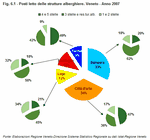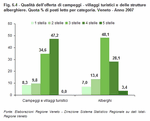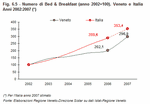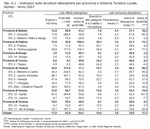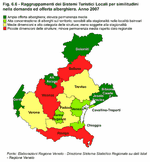|
6 - Quality in the tourist industry
There are over 3,200 hotels in Veneto, a third of which can be found in the historical cities, a third in beach resorts and the remaining third equally divided between the lakes, mountains and spa towns.
Tourists are more and more interested in quality of service and look for places which, as well as being clean and hygienic, are modern, up-to-date and use the latest technologies. Tourists expect not only to be able to relax, to enjoy themselves and to discover new places while on holiday, but also that their accommodation be comfortable, their hosts welcoming, transport reliable and quick, and information readily available. The diversity and quality of the system of accommodation providers in Veneto is constantly being given credit at national and international level. The figures prove this: there are approximately 18 hotels per 100 km2 in Veneto, the average number of bed places equals 64.1, and high category establishments (four and five star hotels) make up 14.4% of all hotels. The slow but continuous increase in the number of top quality establishments, and the corresponding decrease in the number of lower quality establishments shows that in the tourism sector guaranteeing higher quality services has become an absolute must. In the spa towns and historical cities, top quality establishments make up almost 50% of all hotels, whereas in the beach, mountain and lake resorts this figure stands at almost 20%. (Figure 6.1) Conferences
Conferences provide for one slightly unusual area of tourism which is in constant evolution. It is an area which mainly involves hotels. The Veneto region can count over 800 structures providing for this area: 59% of these are hotels; 19.5% historical buildings (villas, palaces and castles); 3% are conference centres which can cater for thousands of conference participants; and 18.6% are places which are usually used for different purposes (town halls, auditoriums, theatres, civic centres etc.). Veneto has almost 200 subjects working within this area (as a primary or secondary concern). There are two types of operators who organise conferences and who manage all of the different stages and services involved: professional conference organisers (25.5%) and travel agents (38.3%). There are also businesses which specialise in providing technical support (13.3%), businesses providing language support and interpreters (19.4%) and, to a lesser extent, businesses providing staff to assist in administration and reception (3.6%). (Figure 6.2)
Let us now focus our attention on the other forms of accommodation such as agrotourism establishments, campsites, tourist villages, and bed and breakfasts, which provide an alternative to the more traditional hotel. These accommodation facilities help satisfy the needs of the new breed of tourists by providing them with a more direct contact with their surroundings, thus allowing them to get to know and to feel more at one with the area visited.
Agrotourism
Agrotourism establishments are becoming ever more popular. They are seen as a way of discovering the diversity of rural areas, tasting the flavours of the land and experiencing nature to the full. This type of accommodation is most suitable for those people who appreciate, or who want to get to know the wealth of traditions and flavours which make up countryside culture. As it takes us into the land itself and close to the towns, this is possibly the most cultural type of tourism, able to satisfy the needs of those interested in art, history, food and wine, traditions and more. One of the main requirements of agrotourism establishments is that they have the facilities to provide accommodation for guests within their own structures and make use of their own produce; an agrotourism enterprise is, in practice, a working agricultural business which also caters for tourists.In Veneto in 2006 there were 1,124 working agrotourism establishments, shared throughout the region. The province of Verona had the most with 260 agrotourism establishments, followed by Treviso with 257. These provide a range of high quality services, which includes providing accommodation (rooms or open spaces), offering food, drink and snacks, selling home produce, and providing facilities for leisure, sports and cultural activities. All of which confirms Veneto entrepreneurs' professionalism and dynamism. Analysis shows that this trend will increase in the future: the number of agrotourism establishments has increased by 11.1% compared to 2005, bringing the total surface area covered by these types of enterprises to more than 35,000 hectares. It is estimated that this trend will further increase by 8.6% in 2007, followed by a further increase, if slightly more restrained, in 2008. Veneto ranks third on a national level for the number of agrotourism establishments, with a 6% share of the national total, behind Toscana and Trentino Alto Adige. This sector has seen continuous growth during the last few years. It is an area of tourism enjoyed by both Italian and international visitors. There are many factors which have contributed to this phenomenon; added to those already mentioned is tourists' desire to find a friendly atmosphere which however is very different from the usual tourist places. The internet has become an extremely useful, if not indispensable means to manage bookings, making it important for businesses to set up their own websites and to keep them constantly updated. (Figure 6.3) Equine tourism
In 2007 Regione Veneto began a three-year project to improve and promote equine tourism. This type of tourism aims to combine art and history with nature and the environment. The intention is to draw up a map of the many existing horse trails, ensuring there are adequate resting places at the beginning and end of each trail and signposting each one in order to create a regional network which will attract horse-riding enthusiasts from all over the world. Environmentally friendliness combined with the leisurely pace of this type of tourism serves to promote the idea of sustainable tourism and enables the tourist to get to know the traditions, the local produce and the agrotourism establishments of our region.Campsites
Campsites and tourist villages provide a further type of holiday accommodation, one which is extremely popular and which can be found within all the sectors: beach, mountain and lake resorts, historical cities and spa towns. Veneto has the highest concentration of campsites in the whole of Italy with almost 190 campsites, 10% of the total number of campsites in Italy. Veneto provides not only the highest number of campsites but also the highest quality ones; there is a larger share of top quality bed places in campsites than in hotels (47.2% compared to 31.5%). Speaking of quality, the prestigious German automobile association, ADAC, which counts more than 15 million members, gave its award for the best campsites of 2007 to 71 European campsites, basing their judgement on very strict and objective criteria. Out of these 71 campsites, 14 were Italian and 9 of those were in Veneto. The award was based on five different areas: catering; washrooms; entertainment; shopping facilities; accommodation. (Figure 6.4)B&Bs
Veneto ranks third on a national level in terms of the number of Bed and Breakfasts, coming in after Lazio and Sicilia. Of all the B&Bs in Italy, 10% can be found in Veneto (Note 1). In 2007, out of the 1,800 or so B&Bs in Veneto, a quarter were to be found in the province of Venezia, 20% in the province of Verona, followed by Padova, Treviso and Belluno with approximately 15% each. There has been a significant increase in this type of accommodation; estimates say that the number has almost tripled in 5 years. It is important to bear in mind that although the number has seen a sharper increase on a national level, Veneto started out with a higher number (it was second only to Lazio), meaning the increase is mainly due to those regions which only recently started producing more B&Bs. (Figure 6.5)To conclude, the importance of developing sustainable tourism in Veneto should be underlined. It is a type of tourism which is able to satisfy the needs of today's tourists whilst safeguarding for the future. It is essential to be able to reassure tourists that their holiday will not adversely affect the environmental and cultural heritage of the place and of the people hosting them. A trip's impact on the environment is starting to heavily influence the decisions of potential visitors to the area; one third of Italian holidaymakers actually take this factor into account when planning their holidays (Note 2). Tourists look for establishments which are environmentally friendly, and the presence of quality marks or certificates has an impact on their decisions. Veneto was the first tourist destination in Europe to receive EMAS (Note 3), a mark given to organisations which show a commitment to improving the quality of the local environmental. Bibione was the first to obtain the certificate, followed by other tourist organisations, including the Parco Nazionale delle Dolomiti Bellunesi and the island of Albarella, in the province of Rovigo.
Hotels are of fundamental importance to Veneto's tourist industry. Along with non-hotel accommodation hotels constitute what is a vast sector for tourist accommodation; both provide hospitality for holidaymakers, although of slightly different types. Veneto's hotel sector, which was traditionally fragmented and consisted of medium to small sized, mainly family oriented hotels, has witnessed an important evolution in the last few years. It has seen an increase in quality, the introduction of hotel chains, longer opening periods and the search for a better relationship with the environment.
Veneto provides various types of accommodation for tourists across the region. The location within the region can lead to notable differences in the nature of the accommodation. It was deemed interesting therefore to use a series of indicators usually employed to evaluate the structural situation of the hotel sector to look at the situation within the region. For each Local Tourism Network (STL) in Veneto (Note 4), the seven indicators illustrated in the table below were taken into consideration; four regard supply and three regard demand (Note 5). Analysis was carried out on these indicators to determine any similarities between territories. This resulted in the identification of four groups: two in which there were strong similarities between the indicators taken into consideration; and two where the similarities were less pronounced. The first group is made up of the STLs of Belluno, Vicenza and Rovigo; only for Rovigo does the STL include the whole province. The three STLs showed lower values compared to the regional average on all of the indicators taken into consideration. This applied both to supply, in terms of the number of establishments in proportion to the territory and resident population, as well as the capacity and category of the establishments, and to demand, in terms of the length of stay and the use of the available establishments. These characteristics were revealed for the whole tourist network of Belluno, namely the Alpago, Longarone, Belluno, Val Belluna and Feltre areas; for the province of Vicenza, excluding the Altopiano di Asiago area; and for the whole of the province of Rovigo. (Table 6.1) The second group includes the cities of Verona and Padova, which are similar to each other in that they both have medium to large-sized, high-category establishments which are well used throughout the year. Treviso and its province also belong to this second group, although its establishments are slightly smaller on average. The beach resorts of Chioggia and Cavallino-Treporti, which make up the third group, stand out due to the high concentration of establishments (18 per 100 kmē in the first case and 49 per 100 kmē in the second), which adds up to a high number of bed places in proportion to the resident population (about 1 per 10 inhabitants). As far as demand is concerned, it should be highlighted that the average length of stay here is around 4 days as opposed to the 3 days average for Veneto hotels. In order to better understand the situation in these beach resorts, and taking into account the fact that season plays an essential role here, the calculations on the index of utilisation for hotel establishments were repeated using data from the summer period only. The results were telling: on average tourists occupied half of the available bed places in the Chioggia area in the period from June to September; for the coastal area of Cavallino this figure was 75%. During the summer period it is also necessary to evaluate the impact of tourist flows with respect to the resident population; in Cavallino above all this figure reaches record heights: if we count visitors to campsites as well as those to hotels, then for every 100 residents there are on average 335 tourists staying in the area every day. The STLs of Venezia and Terme Euganee are also fairly similar to the tourist networks of Chioggia and Cavallino in terms of the high concentration of hotel establishments and for their capacity, but these two places stand out in particular for the high number of high-category establishments, a number which is significantly higher than the regional average. In the province of Venezia, the short average length of stay of 2.3 days is compensated for by the fact that tourism here is more equally distributed throughout the year. The use of available bed places in the area varies from a minimum of 35% in January to 80% in July, but the numbers are steady throughout the year and remain above 70% for all the months from May to October. The fourth group is made up of the Local Tourism Networks of the Dolomiti, Bibione-Caorle, Jesolo-Eraclea and Garda. These all have a high amount of available hotel accommodation in proportion to the resident population, with around 3 bed places per 10 inhabitants. In all of these places the length of stay is above the regional average and in Bibione and Caorle actually exceeds 5 days. For the whole year the index of utilisation of the establishments is not particularly high, but further analysis reveals that during August in Bibione-Caorle and in the Lake Garda area the hotels are almost all full with a percentage of use of above 90%. Altopiano di Asiago shows very similar characteristics to those of the fourth group, apart from the utilisation of the establishments, which depends much more on certain periods of the year and on particular local events. (Figure 6.6)
To gain an overview of the production structure that allows Veneto to satisfy the demand for services generated by the region's considerable inflow of tourists, it is indispensable to understand the quantity and territorial distribution of the production units in the tourist sector. In 2005 there were around 27,000 local units with 111,000 employees and a gross turnover of close to 5 billion euros. These figures refer to the generic section of economic activity entitled "hotels and restaurants" and provide a very close estimate of the figures for the tourism industry (Note 6).
The Veneto ranks second with 9.1% of Italian local units in the sector, after Lombardia which stands head and shoulders over all the other regions with 15%. In terms of the density with which they are distributed over the national territory, our region comes in fifth with 1.5 establishments per km2, surpassing the Italian average of one. In Veneto, for every 100 units, 6.3 are specialised in hotel accommodation and in restaurant catering, which is in line with the national average. It is worth remembering, however, that although tourism is an important industry in Veneto in terms of the number of production units, it does not have the same significance as other sectors such as trade, manufacturing, construction, or others (Note 7). (Figure 6.7) At a provincial level, Venezia and Verona dominate in terms of the number of local units with shares of 24.3% and 20.1% of the regional total respectively. As regards the number of units specialised in this area, Belluno takes the lead with 11.8 units in this sector for every 100 local units, and Venezia also stands out with 9.1%. This analysis is also relevant to employment. A short note on workers in the hotel industry: in 2006 there were an estimated 23,000 employees (Note 8) on average, 84% of whom worked full-time and the remaining 16% part-time, with almost equal distribution between the two sexes (46% men and 54% women). The province of Venezia had the largest share of workers in this sector, with 40% of the regional total, followed by the province of Padova with about 20%.
|
|
Data elaborated by the Statistics office of the Veneto region are collective property; reproduction of this material is authorised for non-commercial purposes only, provided the source "Regione Veneto - Regional Statistics System Management" is acknowledged.


 Index
Index  Home
Home 